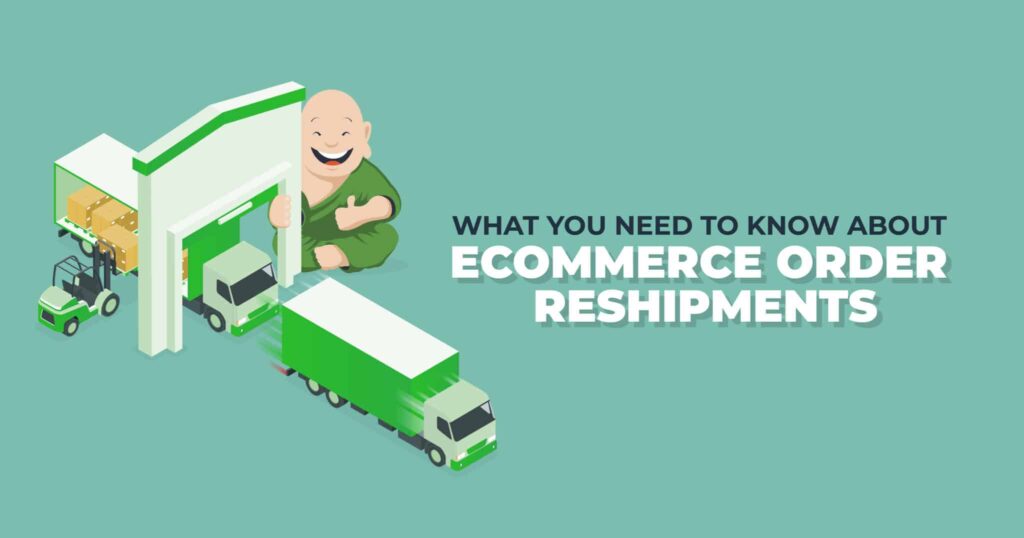Ecommerce businesses depend on 3PL fulfillment companies and shipping carriers to make good on their promises to customers. Those promises include accurate order fulfillment and on-time delivery. But what happens when something goes wrong?
Returns, reshipments, and refunds are all a part of doing business online. The way your ecommerce business responds when things don’t go according to plan defines your business, for better or worse, in the eyes of your customer. So today we’re going to talk about reshipments — what they are, why you need to plan for them, and what you can do to prevent them.
What is a Reshipment?
A reshipment is the process of fulfilling and shipping an ecommerce order a second time because the first order was damaged, lost in transit, or contained the wrong items. Reshipments begin when either the shipping carrier notifies the ecommerce merchant that there’s a problem with the delivery, or the customer contacts the merchant directly with a complaint. Either way, because the customer paid for something they didn’t get, it becomes the merchant’s responsibility to satisfy the customer with a reshipment or refund.
When Are Reshipments Necessary?
There are several possible situations in which an ecommerce business might be expected to send a reshipment.
Damaged Product: A broken or damaged product is the result of a poorly packed box or rough handling during shipment or last mile delivery.
Incorrect Product: The wrong item(s) were delivered, or the customer received someone else’s order. The picker in the warehouse or fulfillment center may have made a mistake, the item may have been mislabeled and slotted incorrectly during the receiving process, or an incorrect shipping label may have been applied.
Lost Package: The package was never delivered. Sometimes this is the result of a damaged shipping label that could not be scanned, but it might also happen if the customer makes a mistake entering their address and nobody catches it. Stolen packages are considered lost, and are also a common cause for reshipment.
***Note – In some cases a customer may request a refund rather than a reshipment, particularly if the item is no longer available, or the customer no longer needs it.
Reshipments vs. Returns & Exchanges
It’s important to note that a reshipment is not the same thing as a return. A reshipment is necessary in any case where the merchant or shipping carrier takes responsibility for the error, damage, or loss. A return, on the other hand, is initiated when the customer receives what they ordered, but is not happy with it. For example, with a clothing item perhaps it didn’t fit, or the customer didn’t like the color, quality, or fabric. They must then return the item and request a refund or an exchange for a different size or color. The customer may or may not have to pay for return shipping, depending on the merchant’s return policy.
A full-service ecommerce fulfillment or third-party logistics provider (3PL) can process both reshipments and returns. In either case it’s important to have procedures in place so your fulfillment provider knows exactly what to do in every possible situation.
Order Tracking
Ecommerce merchants, as well as their customers, can elect to receive automatic delivery status notifications whenever there is an unexpected delay in the normal delivery process. Short delays, such as those caused by weather or a truck breakdown, usually sort themselves out by waiting a day or two. When there is a more serious delay, such as a natural disaster or an incorrect address, the shipping carrier will flag the shipment and, in some cases, notify the ecommerce merchant of a delivery exception. In these circumstances it falls to the merchant to contact the customer and resolve the problem, either by providing the shipping carrier with updated information or reshipping the order.
In these rare instances, it helps if your 3PL has advanced order management software that tracks all order-related information in one place so ecommerce merchants can quickly identify the problem, notify the customer, and enact a solution. If the shipping carrier is at fault, the ecommerce merchant can file a claim with the carrier to recover their costs. Best practices suggest that the merchant satisfy the customer first, then handle the claim with the shipping carrier.
One of the benefits of partnering with a tech-forward 3PL like ShipMonk is having access to robust software that enables order tracking from shopping cart to delivery. ShipMonk’s warehouse fulfillment software integrates fully with the ecommerce merchant’s order processing systems, as well as all the major shipping carrier tracking systems. This gives everyone access to the order status at all times.
In addition, ShipMonk offers MonkProtect™, a service that enables ecommerce merchants to host order tracking and claims processing on their own branded websites. This puts the merchant in control of the customer experience, rather than sending them to FedEx or UPS for information or to file a claim. Since the average customer checks order status 7 times, the ecommerce merchant can use these extra visits to their website to promote their brand and incentivize repeat purchases.
Have a Reshipment Process in Place
When a customer files a complaint there is no point in arguing over who is at fault. The customer doesn’t care; they just want their order. If the shipping carrier is at fault, a claim can be made later to recover reshipment costs, but the ecommerce merchant’s first priority should be satisfying the customer. Four top tips to remember include:
1. Good Communication is Important
Merchants that quickly respond to customer claims rank high in customer satisfaction when compared to those who are slow to respond or do nothing. In the case of a lost package, the ecommerce merchant can help by contacting the shipping carrier to determine the cause of the problem. If a reshipment is necessary, they should let the customer know when they can expect delivery.
2. Make it Simple for Your Customer to File a Claim
Ecommerce businesses can reduce customer frustration by clearly communicating how to file a claim. At minimum, there should be an easy-to-find customer support page on your website with clear instructions on what to do in case of theft, damage, or lost packages. Enclosing a return label in each order is extremely helpful if you wish to recover incorrect or damaged items.
Ecommerce merchants can significantly reduce customer service interactions by offering an online self-service portal for submitting claims, rather than having customers contact customer service for instructions. Online claims filing, such as that offered by MonkProtect™, also simplifies the recovery process for ecommerce businesses by keeping all documentation in one place.
3. Streamline the Reshipment Process
Filing claims, investigating, determining liability, and resolving issues all take time — sometimes weeks. That’s far too long for a customer to wait for an order. Once a claim is filed, it should be reviewed and resolved as quickly as possible. This is another instance where an online portal or automated approval system can streamline the process. You only see the claims that require your attention, and you can quickly authorize a reshipment or a refund. Questionable claims can be flagged for further review to reduce fraud.
Once a reshipment is authorized, the fulfillment center or 3PL needs to know exactly how to handle reshipments so they can jump into action. For example, should reshipments get expedited shipping? Should they include an insert offering a discount on their next order? Any special handling requirements should be clearly communicated with your 3PL to ensure quick turnaround.
4. Offer Shipment Protection
Different shipping services and shipping carriers have their own policies regarding limited liability. This type of shipping “insurance” can be complimentary or paid, depending on the package and the estimated cost of the contents inside. If you frequently ship fragile or expensive items, it makes sense to include additional protection in your shipping charges, or offer it to your customers as an option at checkout.
While these types of protection improve your odds of recovering costs if a claim is necessary, they take a lot of time to process and don’t solve the immediate problem of satisfying the customer. With ShipMonk’s MonkProtect™ post-purchase suite, the customer can opt in at checkout to insure their own packages against theft, loss, or damage starting at $0.97/order. If they need to file a claim, they can do so online and get instant reassurance that their claim is being processed. Status notifications keep customers updated and satisfied from start to finish. On the merchant’s side, claims are centralized and automatically pushed for approval, making the whole process ten times faster than manual claims processing.
How to Minimize Reshipments
The best way to reduce the number of reshipments you’re making is to avoid the mistakes that cause them, if possible. You can’t prevent a hurricane, but there are a few things that your ecommerce business and your 3PL should be able to control.
Packaging: If fragile items are repeatedly broken, or customers are reporting torn or punctured packaging, it may not be the shipping carrier’s fault. Fragile items and heavy items should be tightly packed with proper packing materials or “dunnage” so they don’t shift during transit or last-mile delivery. Work with your 3PL partner to ensure that your products are packed securely to prevent damage. Some 3PLs offer kitting and assembly services, which you can use to pre-pack these items so they can safely be transported with other items in an ecommerce order.
Address Verification: Addresses should be verified before a package is shipped, not after. Verification systems do exist, so if your 3PL isn’t performing this service for you, find one that will.
Order Accuracy: It’s unfortunate if a customer gets the wrong item in their order or another customer’s order altogether. With modernized fulfillment technology, centralized information systems across multiple sales channels and multiple warehouses, and the proper checks in place, these mistakes should be rare. Can your fulfillment provider beat ShipMonk’s 99% accuracy rate?
Shipping Contracts: A 3PL or fulfillment center that pushes all of its orders through one shipping carrier in order to get bulk discounts has no leverage and no other options when something goes wrong. Look for a 3PL with multiple shipping partners and a large-enough order volume that they can negotiate discounts and be adaptable to supply chain adversity. In line with this multi-carrier solution, ShipMonk leverages a carrier-agnostic Virtual Carrier Network (VCN), an advanced transportation management strategy that ensures orders are delivered on-time at the best possible rate.
Is it Time to Rethink Your Approach to Reshipments?
If you’re having to reship orders too often, it may be time to review your fulfillment operations and see where you can improve processes. Contact ShipMonk today to discover how our 99% accuracy rating, powerful 3PL software, and automated fulfillment technology can prevent unnecessary errors and reduce reshipment costs.





